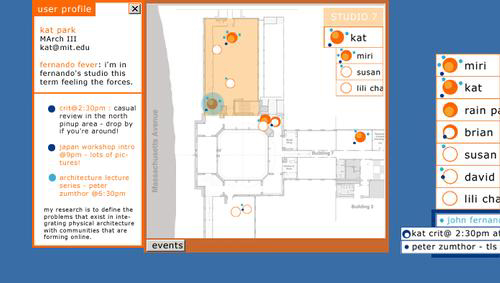StudioMIT-Learning Communities in Design Education
|

StudioMIT explores a new approach to educational technology - one that emphasizes creative learning communities. Just as Thomas Jefferson's University of Virginia campus was intended to bring together and support a community of scholars by architectural means, we aim to sustain and enhance a community of scholars by electronic means.
StudioMIT represents a fundamentally new strategy for professional education in general, and design programs in particular -- a strategy that employs educational technology to build upon the established strengths of the studio method and the design community's extensive experience with it. The strengths of the studio method are its problem-oriented focus, its suitability for engaging complex ill-defined problems that do not have straightforwardly right or wrong answers, its emphasis on creative synthesis, its tradition of subjecting design propositions to rigorous critical discussion from diverse viewpoints, and its emphasis on cross-disciplinary collaborative work. It is in the studio environment that participants find the majority of the resources they need, the support of a cohesive community with a sense of identity and purpose, and the opportunities for collaboration, discussion, and criticism. Our strategy, then, is to create a rich, robust online environment that complements the physical studio environment, allows the physical space and face-to-face interaction to be used most effectively for the things they do best, and provides valuable means for developing and maintaining an intense learning communities among students and faculty.

The main objective of StudioMIT is to design, implement, and maintain a comprehensive Web-based environment that supports the community of students, staff, faculty, alumni and prospective applicants of MIT's studio-centered professional degree programs. StudioMIT will provide crucial infrastructure for a creative learning community that produces and accumulates intellectual products such as architectural designs, digital images, course curricula, and research papers. More than mere online delivery of content, the system includes mechanisms for producing, managing, sharing, and adding value to these intellectual materials.
The core of the system is an open-ended collection of continually updated searchable databases. All community members have individual workspaces which provide them with consistent and personalized entry points to digital image collections, community and class workspaces, exhibition spaces, and communication capabilities. These interactive personal workspaces also allow members to represent themselves and their work to other members of the community. In addition, there are extensive facilities to support discussions, individual work, group work, and the exchange of news allowing distant and local participants to communicate, collaborate, share resources, and develop their own community practices and spirit. We anticipate that the StudioMIT environment will grow in value over time as it captures and preserves the contributions of faculty and of successive generations of students and expands and strengthens the MIT design community.
Currently, the first version of StudioMIT is being tested by a group of pilot classes and communities in which instructors, teaching assistants, and students use the site as their primary web-based location for course lectures, assignment submissions, and discussions. A subset of these StudioMIT members is accessing the site from wireless laptops in the design studios and elsewhere on campus. These laptops, supported by MIT Information Systems, are the result of a grant from the MIT Council on Educational Technology (MITCET) and the d'Arbeloff Award for Excellence in Education to explore the use of the wireless infrastructure. We expect to see many advantages from using the wireless laptops as a predominant delivery point of StudioMIT as students access design resources and their own design work wherever and whenever is most appropriate – in class, in studio, in lab, in the café, in the dorms, or on a design site.

Also as part of StudioMIT and in collaboration with the Social Computing Group at Microsoft Research (MSR), we are developing a joint research project, StudioBridge. StudioBridge is a software application designed to promote and enhance communication between members of the networked community in the Department of Architecture. StudioBridge will deploy the WISH technology developed by Victor Bahl from Microsoft Research and the Bridge Project developed by Microsoft Social Computing Group and MSR intern Shaomin Wang. The WISH technology is a radio-frequency based system used for locating and tracking users on a wireless network. Bridge is a service that publishes real-time location information of a PC connected to 802.11x wireless network. The location information is presented in a graphical form on a building or campus map and also is used for sending alerts or notifications triggered by predefined conditions. StudioBridge will involve transferring this technology from MSR to MIT's Department of Architecture in order to design, prototype, build, and test the new software application focusing on social interactions within the MIT Architecture community.We plan to deploy the system on the wireless laptops in Spring 2002.